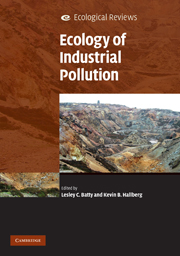Book contents
- Frontmatter
- Contents
- List of contributors
- Preface
- Acknowledgements
- 1 Consequences of living in an industrial world
- 2 Metallophytes: the unique biological resource, its ecology and conservational status in Europe, central Africa and Latin America
- 3 Lichens and industrial pollution
- 4 The impacts of metalliferous drainage on aquatic communities in streams and rivers
- 5 Impacts of emerging contaminants on the environment
- 6 Ecological monitoring and assessment of pollution in rivers
- 7 Detecting ecological effects of pollutants in the aquatic environment
- 8 With the benefit of hindsight: the utility of palaeoecology in wetland condition assessment and identification of restoration targets
- 9 An ecological risk assessment framework for assessing risks from contaminated land in England and Wales
- 10 Diversity and evolution of micro-organisms and pathways for the degradation of environmental contaminants: a case study with the s-triazine herbicides
- 11 The microbial ecology of land and water contaminated with radioactive waste: towards the development of bioremediation options for the nuclear industry
- 12 The microbial ecology of remediating industrially contaminated land: sorting out the bugs in the system
- 13 Ecological recovery in a river polluted to its sources: the River Tame in the English Midlands
- 14 Manchester Ship Canal and Salford Quays: industrial legacy and ecological restoration
- 15 Large-scale mine site restoration of Australian eucalypt forests after bauxite mining: soil management and ecosystem development
- 16 Sustaining industrial activity and ecological quality: the potential role of an ecosystem services approach
- Index
- Plate section
- References
14 - Manchester Ship Canal and Salford Quays: industrial legacy and ecological restoration
Published online by Cambridge University Press: 05 June 2012
- Frontmatter
- Contents
- List of contributors
- Preface
- Acknowledgements
- 1 Consequences of living in an industrial world
- 2 Metallophytes: the unique biological resource, its ecology and conservational status in Europe, central Africa and Latin America
- 3 Lichens and industrial pollution
- 4 The impacts of metalliferous drainage on aquatic communities in streams and rivers
- 5 Impacts of emerging contaminants on the environment
- 6 Ecological monitoring and assessment of pollution in rivers
- 7 Detecting ecological effects of pollutants in the aquatic environment
- 8 With the benefit of hindsight: the utility of palaeoecology in wetland condition assessment and identification of restoration targets
- 9 An ecological risk assessment framework for assessing risks from contaminated land in England and Wales
- 10 Diversity and evolution of micro-organisms and pathways for the degradation of environmental contaminants: a case study with the s-triazine herbicides
- 11 The microbial ecology of land and water contaminated with radioactive waste: towards the development of bioremediation options for the nuclear industry
- 12 The microbial ecology of remediating industrially contaminated land: sorting out the bugs in the system
- 13 Ecological recovery in a river polluted to its sources: the River Tame in the English Midlands
- 14 Manchester Ship Canal and Salford Quays: industrial legacy and ecological restoration
- 15 Large-scale mine site restoration of Australian eucalypt forests after bauxite mining: soil management and ecosystem development
- 16 Sustaining industrial activity and ecological quality: the potential role of an ecosystem services approach
- Index
- Plate section
- References
Summary
Introduction
The upper reaches of the Manchester Ship Canal (MSC) and associated dock basins have been polluted by operational discharges, surface water runoff as well as upstream inputs from the River Irwell. The resulting poor water quality has been exacerbated by the deep (7 m) water column and limited water exchange. In this chapter, we describe the water quality management strategies put in place since the late 1980s to address poor water quality, specifically oxygenation of the water column of the MSC and isolation of the docks from the canal followed by destratification of the water column and habitat diversification. We then examine the effectiveness of these strategies in improving water quality, increasing biodiversity and enhancing the recreational potential of the enclosed dock basins and the MSC.
Establishing an inland port at Manchester
Long before the Industrial Revolution in the late eighteenth century Manchester was already at the centre of numerous industrial settlements located in the foothills of the southwestern Pennines (Gray 1993). The success of local industry rendered the use of traditional transport such as pack-horses and horse-drawn carts inadequate to meet its needs, leading to the increased use of river navigation. The main navigable rivers are the Irwell and Mersey, although water shortages, siltation and mudbanks were obstacles to the reliable transport of goods (Gray 1993). Obstructions had already been cleared in the Mersey estuary to allow vessels to reach Bank Quay, Warrington, and it was suggested that clearing and dredging the Rivers Mersey and Irwell would enable vessels to proceed as far as Manchester (Gray 1993).
- Type
- Chapter
- Information
- Ecology of Industrial Pollution , pp. 276 - 308Publisher: Cambridge University PressPrint publication year: 2010
References
- 5
- Cited by



